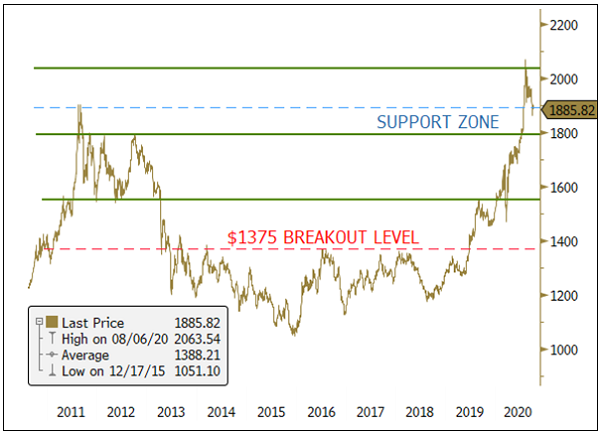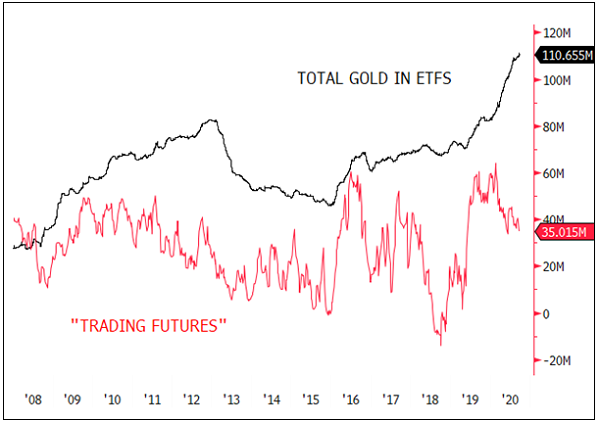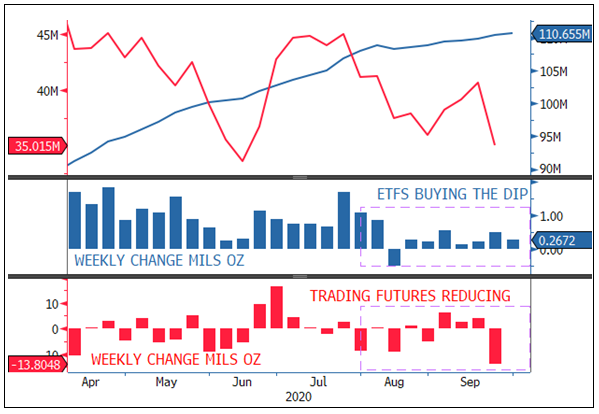Markets experienced the first post-COVID meaningful correction in September as investment fund exposures were reduced, resulting in a contraction in market depth and liquidity. Despite September's profit-taking, gold bullion posted its eighth straight quarterly gain. We see this as a buying opportunity for precious metals investors. My colleague John Hathaway, Senior Portfolio Manager, recommends: "Avoid getting caught up in short-term timing decisions; gold pullbacks should be bought."
September proved less sanguine than August when gold bullion broke out above $2,000 to reach a new all-time high. Although gold bullion fell 4.17% for the month, it is up 24.29% YTD through September 30, 2020, and 28.07% YOY. Both silver bullion and gold mining equities pulled back in September after reaching multi-year highs in August. Despite this, gold mining equities (SGDM)2 have gained 33.43% YTD and 46.22% YOY as of September 30. This compares to 5.57% YTD and 15.05% YOY returns for the S&P 500 TR Index.5 Silver bullion6 is up 30.15% YTD and 36.71% YOY as of September 30.
Month of September 2020
| Indicator | 9/30/2020 | 8/31/2020 | Change | % Chg | Analysis |
| Gold Bullion1 | $1,885.82 | $1,967.80 | ($81.98) | (4.17)% | First post-COVID pull back |
| Silver Bullion6 | $23.24 | $28.14 | ($4.91) | (17.44)% | Selling pressure mainly options based |
| Gold Equities (SGDM)2 | $33.47 | $36.30 | ($2.83) | (7.80)% | Gold equities bouncing off support |
| Gold Equities (GDX)3 | $39.16 | $42.27 | ($3.11) | (7.36)% | Same as above |
| DXY US Dollar Index4 | 93.89 | 92.14 | 1.74 | 1.89% | Short-term oversold bounce |
| S&P 500 Index5 | 3,363.00 | 3,500.31 | (137.31) | (3.92)% | Pullback from extreme overbought |
| U.S. Treasury 10 YR Yield | 0.68% | 0.70% | (0.02)% | (-2.95)% | Very narrow post-COVID range |
| U.S. Treasury 10 YR Real Yield | (0.95)% | (1.10)% | 0.15% | 13.81% | Short-term pause near all-time lows |
| Silver ETFs (Total Known Holdings ETSITITL Index Bloomberg) | 871.48 | 893.43 | (21.95) | (2.46)% | Positioning -2.9% from all-time high |
| Gold ETFs (Total Known Holdings ETFGTOTL Index Bloomberg) | 110.65 | 108.92 | 1.73 | 1.59% | Near all-time high, buying the dip |
Gold Bullion: A Mild, Corrective Pullback
Spot gold bullion fell $82 (or -4.17%) in September to close the month at $1,886. Most of the selling occurred around the September quadruple witching period,7 a typically volatile period. This year's September OpEx (options expiration) had more events than usual (massive post-COVID market rally profit-taking, U.S. election uncertainty, COVID second wave uncertainty, delay in fiscal stimulus, etc.).
From Gold's August 6 peak price of $2,064, gold has corrected to $1,886, down 8.62%. Since breaking out the $1,375 major resistance level, gold bullion has traded in step function manner of channel projections and Fibonacci retracement levels8 acting as support and resistance targets. Currently, gold has pulled back in a typical A-B-C correction back to the support zone of the current trading channel range (see Figure 1).
Figure 1. Gold Bullion Price, Secure within Support Zone

Source: Bloomberg. Data as of 10/01/2020.
Gold Held in ETFs Reflect Long-Term Strength
Breaking down the positioning of gold bullion, gold held in ETFs closed within less than 0.3% of its all-time highs. Gold held in ETFs has long been more representative of fundamental longer-term holders, and less prone to flow trading than gold futures. In Figure 2, we highlight gold holdings in ETFs and a combination of Commodity Futures Trading Commission's (CFTC) Gold Non-Commercial Net Positions9 plus net gold held in managed futures, expressed in millions of ounces.
Gold held in non-commercial and managed futures represents a "trading book," which we call "Trading Futures" for lack of a better descriptor. Gold in ETFs tracks macroeconomic variables (i.e., M2 money supply, the U.S. dollar, real interest rates, etc.) to a high degree (R-squared10 of 0.64 versus R-squared of 0.04 for trading futures since January 2008). The positioning swings in these trading futures account for a large degree of gold's pricing volatility over time. Since 2008, gold trading futures net positioning has averaged 30 million ounces with a two standard deviation band of 0-60 million ounces and has exhibited very choppy trading patterns over the years. Gold in ETFs has a much steadier profile and is more reflective of the longer-term gold picture.
Figure 2. Gold Held in ETFs has Been Steadily Rising

Source: Bloomberg. Data as of 10/1/2020. Scaling is in millions of ounces. The Bloomberg ETFGTOTL index measures all known holdings of gold in ETFs.
Broad Markets' Trading Liquidity and Depth Fading Ahead of Risk Events
Systematic funds re-risking, new retail investors entering and manic options activity created an almost bubble-like stock market melt-up during the summer. Since the stock market's peak, market depth and liquidity have been thinning out. September featured a rather sizeable quadruple witching expiry; exposures to most asset classes were reduced further.
The U.S. presidential election risk has been building and is now the leading risk factor for the markets. We see significantly elevated expected volatility in the options market around election time in early November and for several weeks that follow. For these reasons, investment funds have been reducing their exposures, including gold. This reduction in positioning is reflected in the gold trading futures.
Trading flows in a market with limited market depth and low liquidity will produce wild price swings in all asset classes, including gold. Long-term holders need to separate trading noise from market signals, especially in this environment. As stated earlier, there has been a notable decrease in broad market depth and liquidity. At the same time, options activity has spiked higher, especially in deep OTM ("out of the money") calls.
Combined with increased market dealers hedging activity and funds reducing exposures (reducing longs, covering shorts), September saw some of the widest price swings in asset prices since the March meltdown.
For gold bullion, we see this pullback as a short-term correction driven mainly by fund flows in a thin market. The primary macroeconomic factors remained bullish for gold during this correction, with only minor price changes well within trading bands. In Figure 3, we highlight the most recent flow activity. Gold in ETFs was steadily buying the dips while the gold trading futures were reducing positions (producing the dips).
Figure 3. Positioning Flows: ETFs Buy the Dips Created by Gold Futures
Chart description: The top panel shows gold held in ETFs (blue line, in millions of ounces), and gold held in “trading futures” (red line, net non-comm plus managed futures). The middle panel is the weekly change in the number of ounces of gold held in ETFs. The lower panel is the weekly change in the number of ounces of gold held in trading futures. The trading futures in the last two months (red) have been causing the selling dips in gold. Gold in ETFs (blue) have been buying the dips. Another way of expressing this is that long-term money is buying while "hot money" is selling.

Source: Bloomberg. Data as of 10/1/2020. Scaling is in millions of ounces.
The U.S. Presidential Election, Oh Boy
The upcoming U.S. presidential election is shaping up to be quite unpredictable and chaotic in terms of the possible outcomes. For gold, we see two main results that may have less ambiguity. The first is a Biden-Democratic sweep and a smooth uncontested transition of power. Under this scenario, with Democratic majority control, we expect a much larger fiscal stimulus bill to be passed almost immediately. Debt may increase by $2-3 trillion to finance the additional stimulus plan, the U.S. dollar (USD) will weaken, and breakeven yields will rise, resulting in deeper negative real yields (this assumes the Federal Reserve [Fed]contains nominal yields). This scenario is very bullish for gold, as it is a continuation of current bullish gold dynamics in a more accelerated manner. The other scenario would be a Trump-contested election, resulting in market chaos that leads the Fed to ramp up QE (quantitative easing) to inject liquidity.
Bottom line? Gold could range from outright bullish (flight to safety) to being a relative outperforming asset (systematic liquidity issues). But by definition, chaotic systems are inherently unpredictable.
Silver and Volatility
Silver had a very sharp correction in September, falling more than 17% to close the month at $23.24. We remain bullish on silver despite the recent volatility.
Like gold, the selling in silver was not driven by fundamentals but by forced selling. SLV (iShares Silver Trust, the largest silver ETF) was likely caught in a gamma related selloff, as selling forced dealers to wind down their hedges (to sell SLV) to maintain their delta hedge positions.11 Like selling activity among other asset classes, the silver selloff was not characterized by panic, and although volatility was higher, it was contained.
Gold Equities Still Well Within a Bullish Progression
Gold equities fell 7.4% in September to retest and bounce off of key support (the intersection of chart support, 100-day moving average and Fibonacci retracement levels), Figure 4. Again, the story is the same: Listless trading before a thin volume sharp drop around OpEx and then gradual recovery — all consistent with a correction. Internal breadth measures continue to show bullish leadership (i.e., high beta gold equities are still in an outperformance trend versus gold royalty stocks and other lower beta gold equities). There were also no signs of increased protection buying or hedging (i.e., put buying in GDX or GLD3 remained flat). There were no signs of panic, and daily trading volume remained muted, but there was a noted reduction in open interest (calls and puts) in GLD and GDX. Again, this reduction in open interest occurred across the board in most major asset classes as investment funds reduced exposures throughout September.
The long-term positive fundamentals of gold equities remain unchanged. My colleague Doug Groh, Senior Portfolio Manager, reports: "Miners recently profiled their operations at numerous conferences and despite COVID precautions, profits are robust. Cash costs are much better than ten years ago, and with the better gold prices, balance sheets are in very healthy shape. Free cash flow is being returned to shareholders through dividends and buybacks and is not yet going to expensive projects or acquisitions. We think the late summer pullback in gold equities — which was not dramatic — is constructive given such a strong summer. Autumn pullbacks could be short as Q3 profit reports are likely to be exceptional."
Figure 4. Gold Miners Progressing in Bullish Channel, Bouncing Off Support Zone

Source: Bloomberg. Data as of 10/1/2020. Gold mining equities are measured by GDX.
New (and Improved?) FED Policy Framework
With the September FOMC (Federal Open Market Committee meeting), the Fed policy framework has moved to outcome-based forward guidance and average inflation targeting (AIT). The implications for gold is that future rate hikes will occur only by achieving "maximum employment levels" as defined by the Fed. Not only will Fed policy remain accommodative even after lift-off, but it will be asymmetrical as the Fed will only respond to an inflation shortfall (ignore overshoots, boost if it undershoots). "Lower for longer" is morphing to "lower forever." AIT, however, remains vague. The Fed has not stated how they will achieve an average of 2% inflation. Tolerating and generating 2% inflation are wildly different. For gold, the implications are that severe sell-offs due to events such as the 2013 Taper Tantrum will not occur in this cycle for many years out. A repeat of the Fed rate hikes of 2017 and 2018 will have a much more difficult hurdle to clear in this cycle.
With Yield Curve Control (YCC) shelved for now and Negative Interest Rate Policy (NIRP) a no-go, to achieve the Fed's stated goals of 2% average inflation target, more QE and an increase in the average weighted maturity are the likely main options left. QE on its own, as the past decade has demonstrated, is incapable of generating inflation. The goal of averaging 2% inflation without significant fiscal stimulus is likely to fail much as it had during the prior decade. If the goal is to heat up the economy to get inflation higher, fiscal authorities will need to increase debt and spend. Simultaneously, the monetary policymakers will need to print money and suppress and keep real rates deeply negative. Financial conditions will need to remain accommodative and loose throughout to facilitate the process.
Since the GFC (global financial crisis), the Fed has been printing money and buying bonds, and the proceeds from maturing securities have been continuously reinvested. Positions that are never unwound is essentially debt monetization in a somewhat covert manner. Most notable is the failure of the transmission mechanism as money printing becomes mostly trapped in the banking system, and the velocity of money collapses. Limited money supply makes its way into the real economy resulting in continuous low growth despite massive amounts of QE. Much of the liquidity, however, makes its way into financial assets resulting in asset prices skyrocketing. Soaring debt and asset prices become increasingly untethered to the realities of the economy.
The "Fed Put" Now Applies to Gold
To bypass this broken transmission mechanism and provide more fiscal stimulus, we see central banks edging closer to Modern Money Theory (MMT) or an MMT-like process (whether by design or by necessity). Since COVID, most developed economies have been forced to shift closer towards MMT to deal with the sheer magnitude of stimulus required. The Fed has already monetized the first wave of fiscal stimulus in a swift, coordinated fiscal-monetary policy manner. Bypassing the transmission system (the banks) and going from the central bank directly to the Treasury account is overt debt monetization.
One can easily see the temptation, necessity, or the "logic" of going this route for policymakers down the road, especially when the next crisis hits — the implication for gold is the next level of bullishness. Whether the drift towards MMT continues or not, the Fed cannot allow a meaningful tightening of financial conditions. This means that a stronger USD and higher real yields are not likely to occur without the Fed intervening to restore accommodative conditions.
The "Fed put" now applies to gold.12
| 1 | Gold bullion is measured by the Bloomberg GOLDS Comdty Index. |
| 2 | Sprott Gold Miners Exchange Traded Fund (NYSE Arca: SGDM) seeks investment results that correspond (before fees and expenses) generally to the performance of its underlying index, the Solactive Gold Miners Custom Factors Index (Index Ticker: SOLGMCFT). The Index aims to track the performance of larger-sized gold companies whose stocks are listed on Canadian and major U.S. exchanges. |
| 3 | VanEck Vectors® Gold Miners ETF (GDX®) seeks to replicate as closely as possible, before fees and expenses, the price and yield performance of the NYSE Arca Gold Miners Index (GDMNTR), which is intended to track the overall performance of companies involved in the gold mining industry. The SPDR Gold Shares ETF (GLD) is one of the largest gold ETFs. |
| 4 | The U.S. Dollar Index (USDX, DXY, DX) is an index (or measure) of the value of the United States dollar relative to a basket of foreign currencies, often referred to as a basket of U.S. trade partners' currencies. |
| 5 | The S&P 500 or Standard & Poor's 500 Index is a market-capitalization-weighted index of the 500 largest U.S. publicly traded companies. (TR indicates total return and reflects the reinvestment of any dividends). |
| 6 | Spot silver is measured by Bloomberg Silver (XAG) Spot Rate. |
| 7 | Source: Investopedia. Quadruple witching, occurs on the third Friday of the month of every quarter, in March, June, September, and December, and refers to the simultaneous expiration of single-stock options, single-stock futures, and stock-index options and stock-index futures. |
| 8 | Source: Investopedia. Fibonacci retracement levels are horizontal lines that indicate where support and resistance are likely to occur. They are based on Fibonacci numbers. Each level is associated with a percentage. The percentage is how much of a prior move the price has retraced. The Fibonacci retracement levels are 23.6%, 38.2%, 61.8%, and 78.6%. While not officially a Fibonacci ratio, 50% is also used.The indicator is useful because it can be drawn between any two significant price points, |
| 9 | Commodity Futures Trading Commission's (CFTC) Gold Non-Commercial Net Positions weekly report reflects the difference between the total volume of long and short gold positions existing in the market and opened by non-commercial (speculative) traders. The report only includes U.S. futures markets (Chicago and New York Exchanges). The indicator is a net volume of long gold positions in the United States. |
| 10 | Source: Investopedia. R-squared (R2) is a statistical measure that represents the proportion of the variance for a dependent variable that's explained by an independent variable or variables in a regression model. Source: Investopedia. |
| 11 | Source: Investopedia. Both delta and gamma help to gauge movement in an option's price relative to how in-the-money (ITM) or out-of-the-money (OTM) the option is. Traders hedge delta to limit the risk of small price movements in the underlying security, and hedge gamma to protect themselves from the remaining exposure created through the use of a delta hedge. In other words, hedging gamma should have the effect of protecting the trader's position from movement in the option's delta. |
| 12 | Source: Daytrading.com. The "Fed Put" is the widespread belief that the US Federal Reserve (commonly referenced as "the Fed") can always rescue the economy by decreasing interest rates. |
Don’t miss a golden opportunity.
Now that you’ve gained a deeper understanding about gold, it’s time to browse our selection of gold bars, coins, or exclusive Sprott Gold wafers.
About Sprott Money
Specializing in the sale of bullion, bullion storage and precious metals registered investments, there’s a reason Sprott Money is called “The Most Trusted Name in Precious Metals”.
Since 2008, our customers have trusted us to provide guidance, education, and superior customer service as we help build their holdings in precious metals—no matter the size of the portfolio. Chairman, Eric Sprott, and President, Larisa Sprott, are proud to head up one of the most well-known and reputable precious metal firms in North America. Learn more about Sprott Money.
Learn More
You Might Also Like:

















Looks like there are no comments yet.